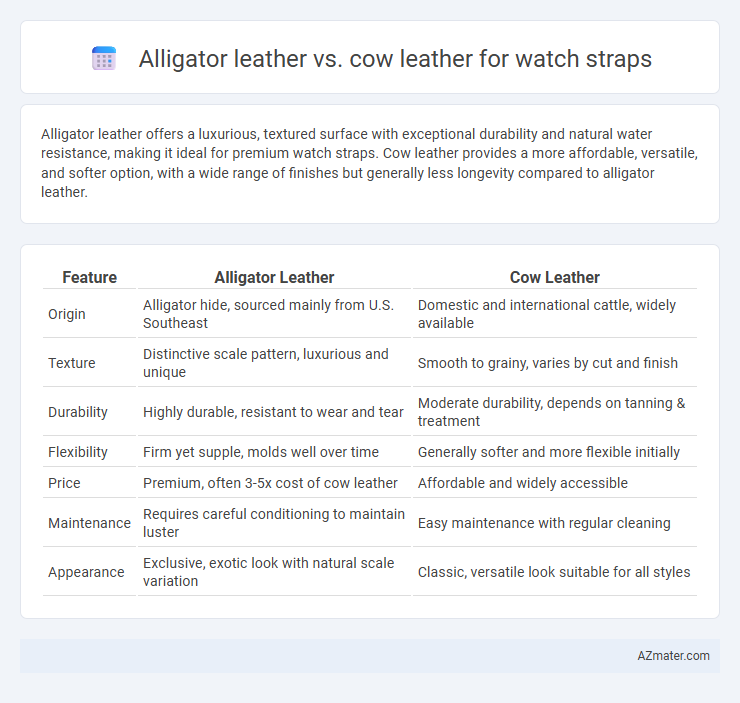Alligator leather offers a luxurious, textured surface with exceptional durability and natural water resistance, making it ideal for premium watch straps. Cow leather provides a more affordable, versatile, and softer option, with a wide range of finishes but generally less longevity compared to alligator leather.
Table of Comparison
| Feature | Alligator Leather | Cow Leather |
|---|---|---|
| Origin | Alligator hide, sourced mainly from U.S. Southeast | Domestic and international cattle, widely available |
| Texture | Distinctive scale pattern, luxurious and unique | Smooth to grainy, varies by cut and finish |
| Durability | Highly durable, resistant to wear and tear | Moderate durability, depends on tanning & treatment |
| Flexibility | Firm yet supple, molds well over time | Generally softer and more flexible initially |
| Price | Premium, often 3-5x cost of cow leather | Affordable and widely accessible |
| Maintenance | Requires careful conditioning to maintain luster | Easy maintenance with regular cleaning |
| Appearance | Exclusive, exotic look with natural scale variation | Classic, versatile look suitable for all styles |
Introduction: Alligator Leather vs. Cow Leather for Watch Straps
Alligator leather offers a distinctive, luxurious texture with natural scale patterns that enhance exclusivity and durability in watch straps. Cow leather provides versatility and affordability, featuring a smoother surface that develops a unique patina over time. Both materials balance comfort and strength, but alligator leather remains the preferred choice for premium, high-end watch straps.
Material Origins and Sourcing
Alligator leather for watch straps is sourced primarily from the alligator species native to the southeastern United States, known for its distinctive scale pattern and natural durability. Cow leather, derived from bovine hides, is more widely available globally and offers a versatile and consistent texture but lacks the unique patterning found in alligator leather. Both materials undergo rigorous tanning processes, with alligator leather often commanding higher prices due to its limited supply and specialized sourcing from sustainable farms.
Texture and Aesthetic Appeal
Alligator leather offers a unique, natural scale pattern that creates a luxurious and exotic texture, making watch straps visually striking and highly sought after in high-end timepieces. Cow leather provides a smoother, more uniform texture that can be polished to various finishes, offering versatility and classic elegance for everyday wear. Both materials age with character, but alligator leather tends to maintain its distinctive texture and premium appeal over time, enhancing the strap's aesthetic value.
Durability and Longevity
Alligator leather offers superior durability and longevity for watch straps due to its dense fiber structure and natural resistance to wear, maintaining its texture and strength over time. Cow leather, while durable, generally wears faster because its fibers are less compact, leading to visible creases and potential cracking with prolonged use. Choosing alligator leather ensures a longer-lasting strap that retains elegance despite daily wear conditions.
Comfort and Flexibility
Alligator leather offers superior comfort due to its naturally softer texture and greater flexibility, molding easily to the wrist for an ergonomic fit. Cow leather, while durable, tends to be stiffer initially and requires a break-in period to achieve similar softness and pliability. The unique grain structure of alligator leather enhances breathability, reducing moisture buildup and improving all-day wear comfort compared to standard cowhide straps.
Water Resistance and Maintenance
Alligator leather watch straps offer superior water resistance compared to cow leather due to their dense scale structure and natural oils that repel moisture, making them ideal for humid or wet conditions. Cow leather straps require regular conditioning and careful drying to prevent water damage, stiffness, or cracking over time. Proper maintenance of alligator leather includes occasional gentle cleaning and conditioning to preserve flexibility, while cow leather demands more frequent care to maintain durability and appearance under exposure to water.
Environmental Impact and Sustainability
Alligator leather production involves farming practices that can disrupt natural ecosystems and contribute to biodiversity loss, while cow leather often comes from large-scale cattle farming with significant greenhouse gas emissions and extensive land and water use. Tanning processes for both leathers frequently rely on harmful chemicals, but vegetable tanning methods are more common in cow leather production, potentially reducing environmental toxicity. Choosing watch straps made from sustainably sourced, vegetable-tanned cow leather typically offers a lower environmental footprint compared to alligator leather derived from wild or farmed exotic reptiles.
Price Comparison and Value for Money
Alligator leather watch straps typically cost significantly more than cow leather due to their rarity, unique texture, and durability, often priced between $200 to $500 or higher. Cow leather straps, ranging from $30 to $100, offer excellent value for money with versatile styles and good durability for everyday wear. While alligator leather delivers luxury and exclusivity, cow leather provides a more affordable and practical option without sacrificing comfort and quality.
Popularity and Brand Preferences
Alligator leather watch straps are highly popular among luxury brands due to their unique, textured pattern and superior durability, often preferred by high-end manufacturers like Rolex, Patek Philippe, and Audemars Piguet. Cow leather remains the most widely used material for watch straps because of its versatility, affordability, and ability to be easily customized, preferred by mainstream brands such as Seiko, Citizen, and Timex. The distinct status symbol of alligator leather contrasts with the practical appeal of cow leather, making each material favored by different segments of watch consumers.
Which Leather is Best for Your Watch Strap?
Alligator leather offers a distinctive, luxurious texture and exceptional durability, making it ideal for high-end watch straps that require a sophisticated appearance and long-lasting wear. Cow leather, by contrast, provides versatility, affordability, and a wider range of finishes, appealing to those seeking comfort and everyday toughness without the premium price. When choosing the best leather for your watch strap, consider the desired aesthetic, budget, and durability needs, with alligator leather delivering prestige and cow leather offering practical resilience.

Infographic: Alligator leather vs Cow leather for Watch strap
 azmater.com
azmater.com